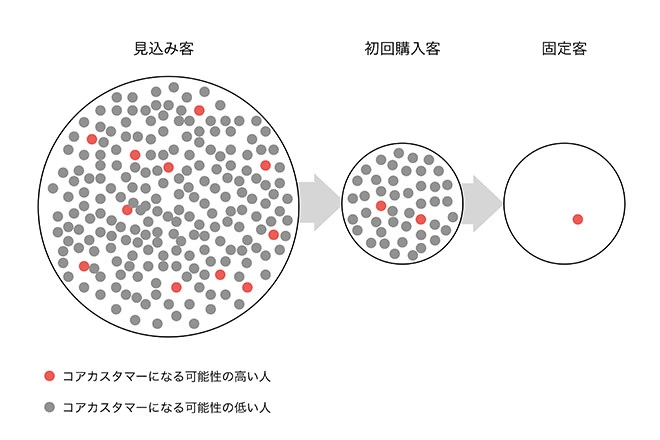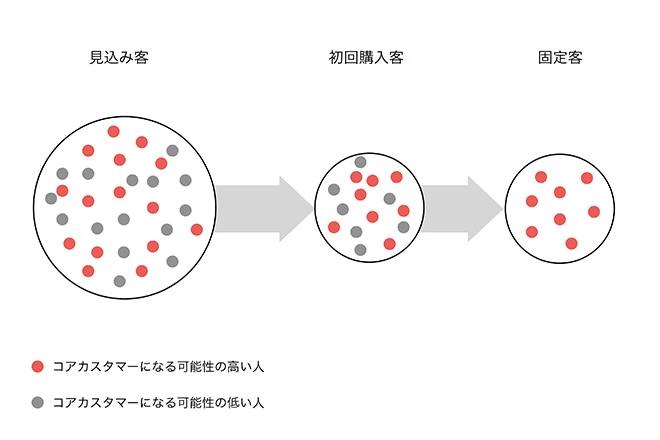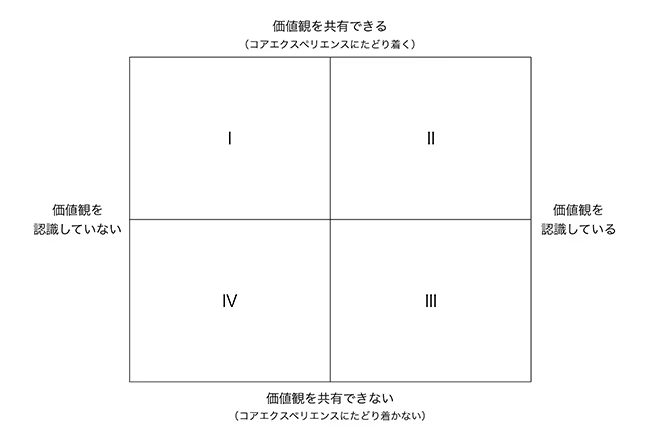みなさん、こんにちは。モノサス代表の林です。
これまで3回にわたってコアカスタマーに集まってもらうための取り組みとして
Step.3、「力を集める」についてお話ししてきました。
前回は
- 多くの企業が見込み客を集めすぎている。
- ターゲット客層の中で、コアカスタマーになりうるのは限られており、割合を求めてみると、その比率は1%以下ということも多い
- したがって、見込み客リストとして多くのリストを集めてもコアエクスペリエンスにたどりつくことのない顧客のリストが大量にできている。
- つまりは99%コアカスタマーになる可能性のないリストに対してマーケティング活動をしていることになり、多くの手間とコストが無駄になっている
ということをお伝えしました。
今回からは力を集めるためるための施策の組み立てに入っていきたいと思います。
見込み客を絞りこむ。
前回までにお話ししたファネルモデルをベースにしたマーケティングの課題を
図式化すると、下記のようになります。

ほとんど選別することなくマーケットから見込み客を集めてくるため、
見込み客リストの中には、ほとんどコアカスタマーになりうる層が含まれていません。
その結果、当然ですが固定顧客化する数は限られています。
一方、私がお話ししているのは、下記の図のような考えです。

見込み顧客化した時点で、かなり絞り込まれたリストにしてしまい、
きちんと利用体験を経たうえで、固定顧客になっていただくのです。
(どちらの図もわかりやすくするためにかなりデフォルメしています)
なぜこのような考えをする必要があるのでしょうか。
なんとなくの1,000人にすべてのリソースをとられている。
大量の見込み客と、初回購入客を抱えたマーケティング担当者は
同時に大きな課題を抱え込んでいます。
限られた自社のマーケティングリソースで、見込み客や、初回購入客に
次のフェーズに進んでもらえるようにアプローチをしなければなりません。
ところが多くの見込み客を抱えると、どうしても対応が「1対多数」にならざるを得ません。
それによって、個別に対応することなど到底できず
メルマガを送る、DMを送るなど、こちらから一方的に情報を伝え、
顧客側が次のアクションに進んでくれることを待つという
施策が中心になってしまうのです。
また、1対多数を相手にこのような施策をとるということは、
コアエクスペリエンスに到達するかどうかを、顧客まかせにするということを意味します。
コアエクスペリエンスへの到達を顧客まかせにすることは、
企業にとっては致命的な機会損失になりかねません。
コアエクスペリエンスに到達する人が限られることは
これまで何度も触れてきましたが、例えコアエクスペリエンスに
たどりつく可能性がある人でも、自分の力だけで到達できる人は
さらに限られています。
つまり、もしうまくコアカスタマーになる可能性の高い人を
見込み客にできたとしても、そのままでは、ほとんどの人が
コアエクスペリエンスにたどり着かず、したがって
コアカスタマーになることなく、休眠客化してしまいます。
大切なことなので、もう少し説明したいと思います。
コアエクスペリエンスにたどり着くかどうかというのは、
簡潔にいうと、企業と顧客が価値観を共有できるかどうかにかかっています。
このことについては以前もお話ししました。
この場合の価値観とは、人生全体の価値観まで広義に捉えるのではなく、
あくまでその商品・サービスとその周辺の物事についての価値観と捉えてください。
もちろん、ある商品・サービスに対する価値観は、その人の人生の価値観と
密接に結びついていますが、ここではあえてその点は考慮しません。
企業と価値観を共有できるかどうかに加えて、もうひとつ大切な軸があります。
それは、顧客自身が自分の価値観を認識しているか、認識していないかということです。
価値観を認識しているかどうかとは、該当する商品・サービスやその周辺の物事について、
顧客の価値観を、顧客自身がどれくらい正確に把握しているかということです。
これは、商品・サービスへの顧客の成熟度に大きく影響をうけます。
例えばクラシック音楽であれば、ただのクラシック音楽に興味がある段階の人もいれば、
最初の数秒聴いただけで、どの作曲家のなんという曲かほとんどわかってしまうような
人もいます。
飲食店であれば、美味しいものは好きだけどなんでも美味しく感じるという人もいれば、
微妙な調理法の違いや、素材の質まで食べただけで判断できてしまう人もいます。
これらの成熟は「和食の中ではこういう味、サービス、価格帯が好き」といった
価値観の認識へとつながります。
繰り返しその商品・サービスを消費することによって、顧客の中に経験値がたまり、
顧客自身が「自分はこういう商品・サービスが好きなんだ」という
傾向を知り、誰に説明されることもなく商品・サービスが自分の価値観に
フィットしているかどうかを判断できるようになるのです。
これらを二本の軸としてマトリクス化すると、
下図のようになります。

つまり、上記の4つの象限の客層について言語化してみると
Ⅰ.価値観を共有できる可能性は高いが、商品・サービスへの知識・経験が乏しく、
価値観を認識していない。したがって独力ではコアエクスペリエンスに
たどり着くことができない。
Ⅱ.価値観を共有できる可能性が高く、商品・サービスへの知識・経験も豊富で
価値観を認識している。独力でコアエクスペリエンスにたどり着くことができる。
Ⅲ.商品・サービスへの知識・経験が豊富で価値観を認識しているが、
価値観を共有できる可能性は低い。明確に自身にあわないポイントを認識したうえで
自社の顧客になることをやめる。
Ⅳ.商品・サービスへの知識・経験が乏しく価値観を認識しておらず、
価値観を共有できる可能性も低い。よくわからないままなんとなく離脱する。
となります。
ここで問題なのは、価値観を認識している顧客に比べて、
価値観を認識していない顧客の方が圧倒的に多いことです。
「自分の価値観くらい認識している」と多くの方が思うかもしれませんが、
価値観を認識するためには、購買経験の多寡だけでなく、商品・サービスへの知識や、
それを得るためのモチベーションが必要です。
ためしにあなた自身が、一体どれくらいの商品・サービスについて
コアエクスペリエンスにたどり着けるほどの、モチベーションと知識を
持ち合わせているか考えてみてください。
「ある」と思っていても、実際に数えてみるといくつもないのではないでしょうか。
ほとんどの顧客は「なんとなく」商品・サービスを消費しているのです。
その結果、Ⅰ.の客層は価値観を共有できる可能性があるにも関わらず、
価値観を認識していないために、独力ではコアエクスペリエンスにたどり着けず
コアカスタマーにならないまま離脱してしまうのです。
つまり、コアエクスペリエンスへの到達を顧客まかせにしていては、
Ⅱ.の限られた客層しかコアカスタマーとして継続的にお付き合いしてはもらえないのです。
私はよく、
なんとなくの1,000人を集めるよりも、
10人の価値観を共有できそうな人を集めるという言い方をしますが、
極端なようで、これくらい絞りこまないことには、
企業はなんとなくの1,000人への対応で
全てのマーケティングリソースを使い果たしてしまっているのです。
1対1で対応できる人数まで、見込み客を絞る。
そこで重要なのは、見込み客を絞りこむだけでなく、
見込み客に対してできる限り個別に対応をすることです。
業種・業態問わず、できれば1対1に近い対応をできるところまで
絞りこむことが重要です。
また、ただ個別で対応すればよいのではなく、
顧客が商品・サービスへの価値観を認識するサポートをする必要があります。
見込み客の数を絞る必要があるのは、
1対1、もしくはそれに近い状態で顧客をサポートすることに
マーケティングのリソースを集中させるためといっても過言ではありません。
長くなりましたので今月はここまでにしたいと思います。
来月は価値観を認識するためのサポートのために
必要な施策の内容をお伝えしたいと思います。
今月も最後までお読みいただきありがとうございます。

